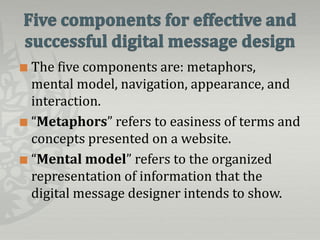The document discusses theories of digital message design. It outlines five components of constructive design communication: metaphors, mental model, navigation, appearance, and interaction. It also discusses principles like usability, relevance of information, and strategies for return visits. Grid models and theories of semiotics, depiction, detection, and nonperceptual interpretation are presented as useful frameworks for digital message design. Usability, learnability, efficiency, memorability, errors, and subjective satisfaction should all be considered to create effective user-friendly design.























